Municipal and Urban Renewal Development Index System: A Data-Driven Digital Analysis Framework
Abstract
1. Introduction
2. Municipal and Urban Renewal Development Index (MUDI) System
2.1. MUDI Data Model Building
2.2. MUDI Design and Specification
2.3. MUDI System Dimensionality and Correlation Study
2.4. AI-Driven Temporal Land Change Study by Applying MUDIs to Evaluate Urban Renewal Progress
3. MUDI System Setup: Study Area and Datasets
3.1. MUDI Study Area
3.2. Datasets
4. MUDI System Setup and Study for 337 Cities and Xiamen’s Yingping District and 285 Residential Communities
4.1. MUDI Setup
4.1.1. MUDIs for 337 Cities
4.1.2. Yingping District’s Data Model and MUDI Setup
4.1.3. MUDI Green Ecology Index-Based Land Change Study for 285 Residential Communities
4.2. MUDI System Methodology and Analysis
4.2.1. UMAP Classification and Correlation Study for 337 Cities
- The original data were processed with missing values and standardization.
- The UMAP algorithm was applied to the data, mapping high-dimension data to a 2D space and classifying the data.
- We selected 34 group 1 cities and 34 group 2 cities based on the results. The data of the selected cities were further analyzed by means of a dimension reduction and main components study.

4.2.2. PCA Dimension Reduction and Main Components Study for Group 1 and 2 Cities
- 4.
- The original data were processed with missing values and standardization.
- 5.
- The PCA algorithm was applied to the data, determining the number of principal components according to whether the eigenvalue was greater than 1.
- 6.
- We calculated the index weights based on the principal components’ load matrixes, eigenvalues, and variances. Then, we rank the indexes from high to low to compare and analyze the importance of the MUDIs of the group 1 cities and group 2 cities.
4.2.3. PCA–UMAP Analysis for Group 1 and 2 Cities
4.2.4. MUDI Analysis for Yingping District’s Urban Renewal Development
4.2.5. MUDI Green Ecology Index-Based Land Change Analysis for 285 Residential Communities in Xiamen
5. Results and Analysis
5.1. MUDI Experiments and Analysis
5.1.1. MUDI Classification and Correlation Analysis for 337 Cities
5.1.2. MUDI Component and Correlation Analysis
Group 1 Cities Analysis
Group 2 Cities Analysis
5.1.3. MUDI PCA Dimension Reduction and UMAP Finer Classification Analysis
5.2. MUDIs for Yingping District’s Urban Renewal Development Analysis in Xiamen
5.3. MUDI Green Ecology Index-Based Land Change Analysis for 285 Residential Communities
6. Discussion
6.1. MUDI-Based Dimensionality and Correlation Analysis
6.2. MUDI-Based City Finer Classification Analysis
6.3. MUDI-Based Yingping District’s Urban Renewal Analysis
6.4. MUDI Green Ecology Index-Based Land Change Analysis for 285 Residential Communities
6.5. Limitations and Future Research
7. Conclusions
Author Contributions
Funding
Data Availability Statement
Acknowledgments
Conflicts of Interest
References
- United Nations. World Urbanization Prospects: The 2014 Revision; United Nations: New York, NY, USA, 2015. [Google Scholar]
- Zhu, M.; Shen, L.; Tam, V.W.; Liu, Z.; Shu, T.; Luo, W. A load-carrier perspective examination on the change of ecological environment carrying capacity during urbanization process in China. Sci. Total Environ. 2020, 714, 136843. [Google Scholar] [CrossRef]
- The World Bank. Available online: https://www.worldbank.org/en/topic/urbandevelopment/overview (accessed on 16 July 2020).
- Angel, S.; Parent, J.; Civco, D.L.; Blei, A.; Potere, D.T. The dimensions of global urban expansion: Estimates and projections for all countries, 2000–2050. Prog. Plan. 2011, 75, 53–107. [Google Scholar] [CrossRef]
- Urban Climate Action—The Urban Content of the NDCs: Global Review. 2022. Available online: https://unhabitat.org/urban-climate-action-the-urban-content-of-the-ndcs-global-review-2022 (accessed on 10 January 2023).
- Fernández, J. Resource Consumption of New Urban Construction in China. J. Ind. Ecol. 2007, 11, 99–115. [Google Scholar] [CrossRef]
- Renard, F.; Alonso, L.; Fitts, Y.; Hadjiosif, A.; Comby, J. Evaluation of the Effect of Urban Redevelopment on Surface Urban Heat Islands. Remote Sens. 2019, 11, 299. [Google Scholar] [CrossRef]
- Maity, J.P.; Bundschuh, J.; Chen, C.; Bhattacharya, P. Microalgae for third generation biofuel production, mitigation of greenhouse gas emissions and wastewater treatment: Present and future perspectives—A mini review. Energy 2014, 78, 104–113. [Google Scholar] [CrossRef]
- Graymore, M.; Sipe, N.G.; Rickson, R.E. Sustaining Human Carrying Capacity: A tool for regional sustainability assessment. Ecol. Econ. 2010, 69, 459–468. [Google Scholar] [CrossRef]
- Jeon, J.; Suh, Y. Analyzing the Major Issues of the 4 th Industrial Revolution. Asian Soc. Innov. Policy 2017, 6, 262–273. [Google Scholar]
- Gong, P.; Yu, L.; Li, C.; Wang, J.; Liang, L.; Li, X.; Ji, L.; Bai, Y.; Cheng, Y.; Zhu, Z. A new research paradigm for global land cover mapping. Ann. GIS 2016, 22, 87–102. [Google Scholar] [CrossRef]
- Chen, B.; Xu, B.; Gong, P. Mapping essential urban land use categories (EULUC) using geospatial big data: Progress, challenges, and opportunities. Big Earth Data 2021, 5, 410–441. [Google Scholar] [CrossRef]
- LeCun, Y.; Bengio, Y.; Hinton, G. Deep learning. Nature 2015, 521, 436–444. [Google Scholar] [CrossRef]
- Loveland, T.R.; Reed, B.C.; Brown, J.F.; Ohlen, D.; Zhu, Z.; Yang, L.; Merchant, J.W. Development of a global land cover characteristics database and IGBP DISCover from 1 km AVHRR data. Int. J. Remote Sens. 2010, 21, 1303–1330. [Google Scholar] [CrossRef]
- UCL-Geomatics. Land Cover CCI Product User Guide Version 2.0. 2017. Available online: http://maps.elie.ucl.ac.be/CCI/viewer/download/ESACCI-LC-Ph2-PUGv2_2.0.pdf (accessed on 23 February 2023).
- Chen, J.; Chen, J.; Liao, A.; Cao, X.; Chen, L.; Chen, X.; He, C.; Han, G.; Peng, S.; Lu, M.; et al. Global land cover mapping at 30 m resolution: A POK-based operational approach. ISPRS J. Photogramm. Remote Sens. 2015, 103, 7–27. [Google Scholar] [CrossRef]
- Amini, S.; Saber, M.; Rabiei-Dastjerdi, H.; Homayouni, S. Urban Land Use and Land Cover Change Analysis Using Random Forest Classification of Landsat Time Series. Remote Sens. 2022, 14, 2654. [Google Scholar] [CrossRef]
- Yao, Y.; Li, J.; Zhang, X.; Duan, P.; Li, S.; Xu, Q. Investigation on the Expansion of Urban Construction Land Use Based on the CART-CA Model. ISPRS Int. J. Geo Inf. 2017, 6, 149. [Google Scholar] [CrossRef]
- Swetanisha, S.; Panda, A.R.; Behera, D.K. Land use/land cover classification using machine learning models. Int. J. Electr. Comput. Eng. 2022, 12, 2040–2046. [Google Scholar] [CrossRef]
- Pendlebury, J.; Porfyriou, H. Heritage, urban regeneration and place-making. J. Urban Des. 2017, 22, 429–432. [Google Scholar] [CrossRef]
- Landa, F. Actual Changes in System of Urban Planning in Post-Socialist City: The Case of Prague. J. Archit. Urban. 2016, 40, 303–310. [Google Scholar] [CrossRef]
- Global Forum on Human Settlements. Available online: https://gfhsforum.org/?_l=en (accessed on 18 December 2022).
- European Environment Agency. Available online: https://www.eea.europa.eu (accessed on 18 December 2022).
- PlaNYC Progress Report. Available online: https://climate.cityofnewyork.us/reports/planyc-reports/ (accessed on 5 January 2023).
- The Annual Planning Monitoring Report (AMR) in London. Available online: https://www.london.gov.uk/programmes-strategies/planning/implementing-london-plan/monitoring-london-plan (accessed on 11 January 2023).
- Shach-Pinsly, D. Digital Urban Regeneration and Its Impact on Urban Renewal Processes and Development. Urban Plan. 2021, 6, 135–138. [Google Scholar] [CrossRef]
- Shach-Pinsly, D.; Bindreiter, S.; Porat, I.; Sussman, S.; Forster, J.; Rinnerthaler, M. Multiparametric Analysis of Urban Environmental Quality for Estimating Neighborhood Renewal Alternatives. Urban Plan. 2021, 6, 172–188. [Google Scholar] [CrossRef]
- Tanrıkul, A.; Hoşkara, Ş. A New Framework for the Regeneration Process of Mediterranean Historic City Centres. Sustainability 2019, 11, 4483. [Google Scholar] [CrossRef]
- Benkő, M.; Bene, B.; Pirity, Á.; Szabó, Á.T.; Egedy, T. Real vs. Virtual City: Planning Issues in a Discontinuous Urban Area in Budapest’s Inner City. Urban Plan. 2021, 6, 150–163. [Google Scholar] [CrossRef]
- Praharaj, S. Area-Based Urban Renewal Approach for Smart Cities Development in India: Challenges of Inclusion and Sustainability. Urban Plan. 2021, 6, 202–215. [Google Scholar] [CrossRef]
- Gutting, R.; Gerhold, M.; Rößler, S. Spatial Accessibility in Urban Regeneration Areas: A Population-Weighted Method Assessing the Social Amenity Provision. Urban Plan. 2021, 6, 189–201. [Google Scholar] [CrossRef]
- Shih, C.; Treija, S.; Zaleckis, K.; Bratuškins, U.; Chen, C.; Chen, Y.H.; Chiang, C.T.; Jankauskaitė-Jurevičienė, L.; Kamičaitytė, J.; Koroļova, A.; et al. Digital Placemaking for Urban Regeneration: Identification of Historic Heritage Values in Taiwan and the Baltic States. Urban Plan. 2021, 6, 257–272. [Google Scholar] [CrossRef]
- Wand, F.; Shi, X.; Zheng, H.; Wu, Y. The Crucial Question and Ten Relationships: Reforming Exploration of Beijing Master Plan 2016–2035. Les Cahiers 176-Les villes changent le monde. L’institut Paris Region. Juillet 2020. [Google Scholar]
- Li, Z.; He, S.; Su, S.; Li, G.; Chen, F. Public Services Equalization in Urbanizing China: Indicators, Spatiotemporal Dynamics and Implications on Regional Economic Disparities. Soc. Indic. Res. 2020, 152, 1–65. [Google Scholar] [CrossRef]
- Lucy, W.H.; Gilbert, D.; Birkhead, G.S. Equity in local service distribution. Public Adm. Rev. 1977, 37, 687–697. [Google Scholar] [CrossRef]
- Liao, Z. The analysis of basic public service supply regional equalization in China’s provinces—Based on the Theil Index evaluation. IOP Conf. Ser. Earth Environ. Sci. 2017, 100, 012106. [Google Scholar] [CrossRef]
- Ardeshiri, A.; Willis, K.; Ardeshiri, M. Exploring preference homogeneity and heterogeneity for proximity to urban public services. Cities 2018, 81, 190–202. [Google Scholar] [CrossRef]
- Zhang, X.; Feng, Z. Spatial Correlation and Regional Convergence in per-capita GDP in China: 1978–2003. China Econ. Q. 2008, 7, 399. [Google Scholar]
- Schneider, M. Local fiscal equalisation based on fiscal capacity: The case of Austria. Fisc. Stud. 2002, 23, 105–133. [Google Scholar] [CrossRef]
- Li, P.; Lu, Y.; Wang, J. Does flattening government improve economic performance? Evidence from China. J. Dev. Econ. 2016, 123, 18–37. [Google Scholar] [CrossRef]
- Chen, J.; Fleisher, B.M. Regional income inequality and economic growth in China. J. Comp. Econ. 1996, 22, 141–164. [Google Scholar] [CrossRef]
- Saaty, T.L. The Analytic Hierarchy Process; RWS Publications: Pittsburgh, PA, USA; McGrew Hill: New York, NY, USA, 1980; Volume 9, pp. 19–22. [Google Scholar]
- Xie, G.D.; Zhen, L.; Lu, C.X.; Xiao, Y.; Chen, C. Expert knowledge based valuation method of ecosystem services in China. J. Nat. Resour. 2008, 23, 911–919. [Google Scholar]
- Benito, B.; Faura, Ú.; Guillamón, M.D.; Ríos, A.M. The efficiency of public services in small municipalities: The case of drinking water supply. Cities 2019, 93, 95–103. [Google Scholar] [CrossRef]
- Zere, E.; Mandlhate, C.; Mbeeli, T.; Shangula, K.; Mutirua, K.; Kapenambili, W. Equity in health care in Namibia: Developing a needs-based resource allocation formula using principal components analysis. Int. J. Equity Health 2017, 6, 3. [Google Scholar] [CrossRef]
- Hartmann, T.; Jehling, M. From diversity to justice—Unraveling pluralistic rationalities in urban design. Cities 2019, 91, 58–63. [Google Scholar] [CrossRef]
- Duch-Zebrowska, P.; Zielonko-Jung, K. Integrating Digital Twin Technology Into Large Panel System Estates Retrofit Projects. Urban Plan. 2021, 6, 164–171. [Google Scholar] [CrossRef]
- Wang, X.; Chen, B.; Li, X.; Zhang, Y.; Ling, X.; Wang, J.; Li, W.; Wen, W.; Gong, P. Grid-Based Essential Urban Land Use Classification: A Data and Model Driven Mapping Framework in Xiamen City. Remote Sens. 2022, 14, 6143. [Google Scholar] [CrossRef]
- McInnes, L.; Healy, J.; Saul, N.; Großberger, L. UMAP: Uniform Manifold Approximation and Projection. J. Open Source Softw. 2018, 3, 861. [Google Scholar] [CrossRef]
- Leland, M.; John, H. UMAP: Uniform Manifold Approximation and Projection for Dimension Reduction. arXiv 2020, arXiv:1802.03426. [Google Scholar]
- Jolliffe, I.T.; Cadima, J. Principal component analysis: A review and recent developments. Philos. Trans. A Math. Phys. Eng. Sci. 2016, 374, 20150202. [Google Scholar] [CrossRef] [PubMed]
- Bao, H.; Ming, D.; Guo, Y.; Zhang, K.; Zhou, K.; Du, S. DFCNN-Based Semantic Recognition of Urban Functional Zones by Integrating Remote Sensing Data and POI Data. Remote Sens. 2020, 12, 1088. [Google Scholar] [CrossRef]
- Du, S.; Du, S.; Liu, B.; Zhang, X. Incorporating DeepLabv3+ and object-based image analysis for semantic segmentation of very high resolution remote sensing images. Int. J. Digit. Earth 2020, 14, 357–378. [Google Scholar] [CrossRef]
- Guo, M.; Xu, T.; Liu, J.; Liu, Z.; Jiang, P.; Mu, T.-J.; Zhang, S.-H.; Martin, R.R.; Cheng, M.-M.; Hu, S.-M. Attention mechanisms in computer vision: A survey. Comput. Vis. Media 2022, 8, 331–368. [Google Scholar] [CrossRef]
- Radford, A.; Narasimhan, K. Improving Language Understanding by Generative Pre-Training. Comput. Sci. 2018. [Google Scholar]
- Vaswani, A.; Shazeer, N.M.; Parmar, N.; Uszkoreit, J.; Jones, L.; Gomez, A.N.; Kaiser, Ł.; Polosukhin, I. Attention is All you Need. Neural Inf. Process. Syst. 2017, 30, 5998–6008. [Google Scholar]
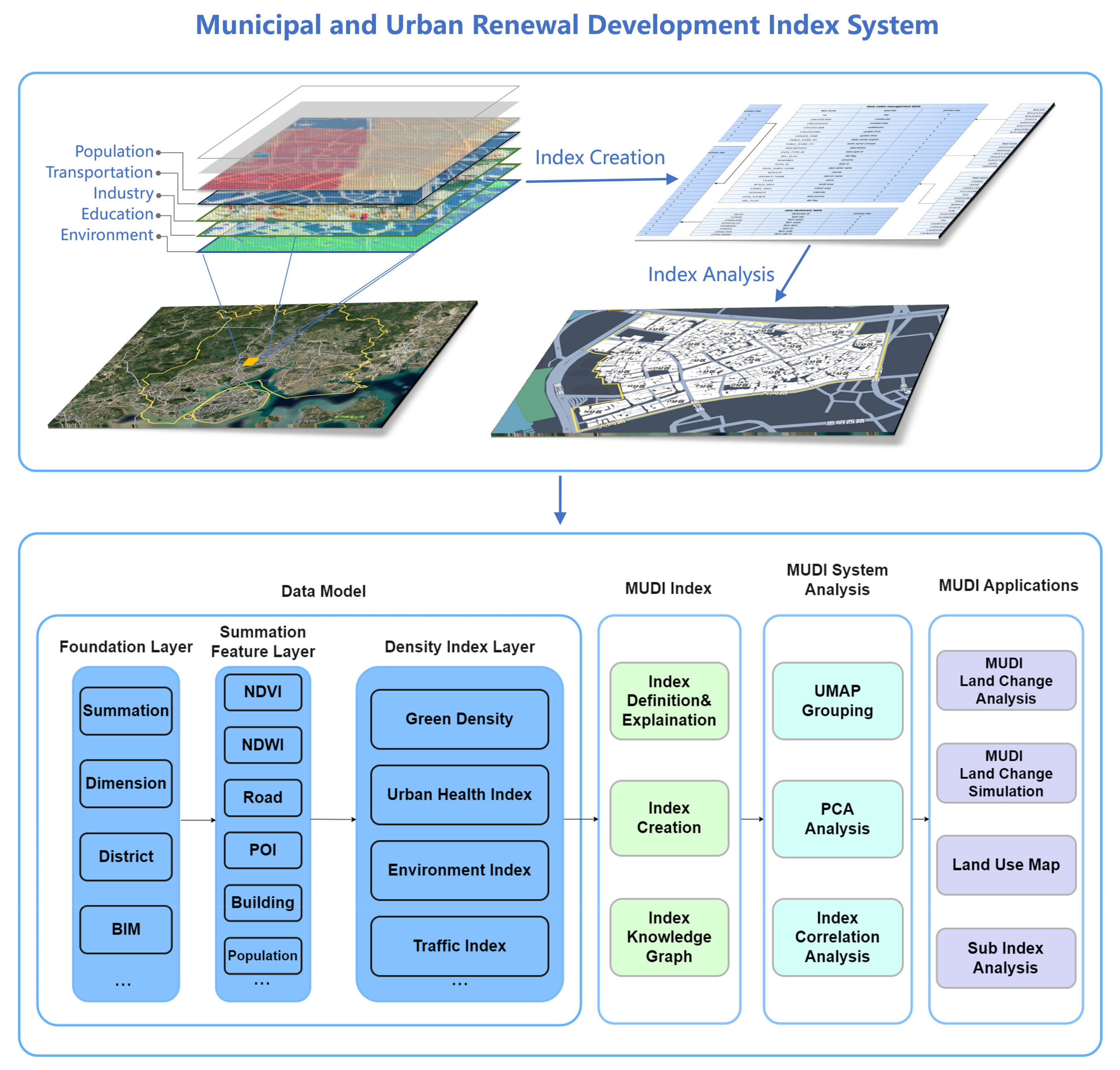



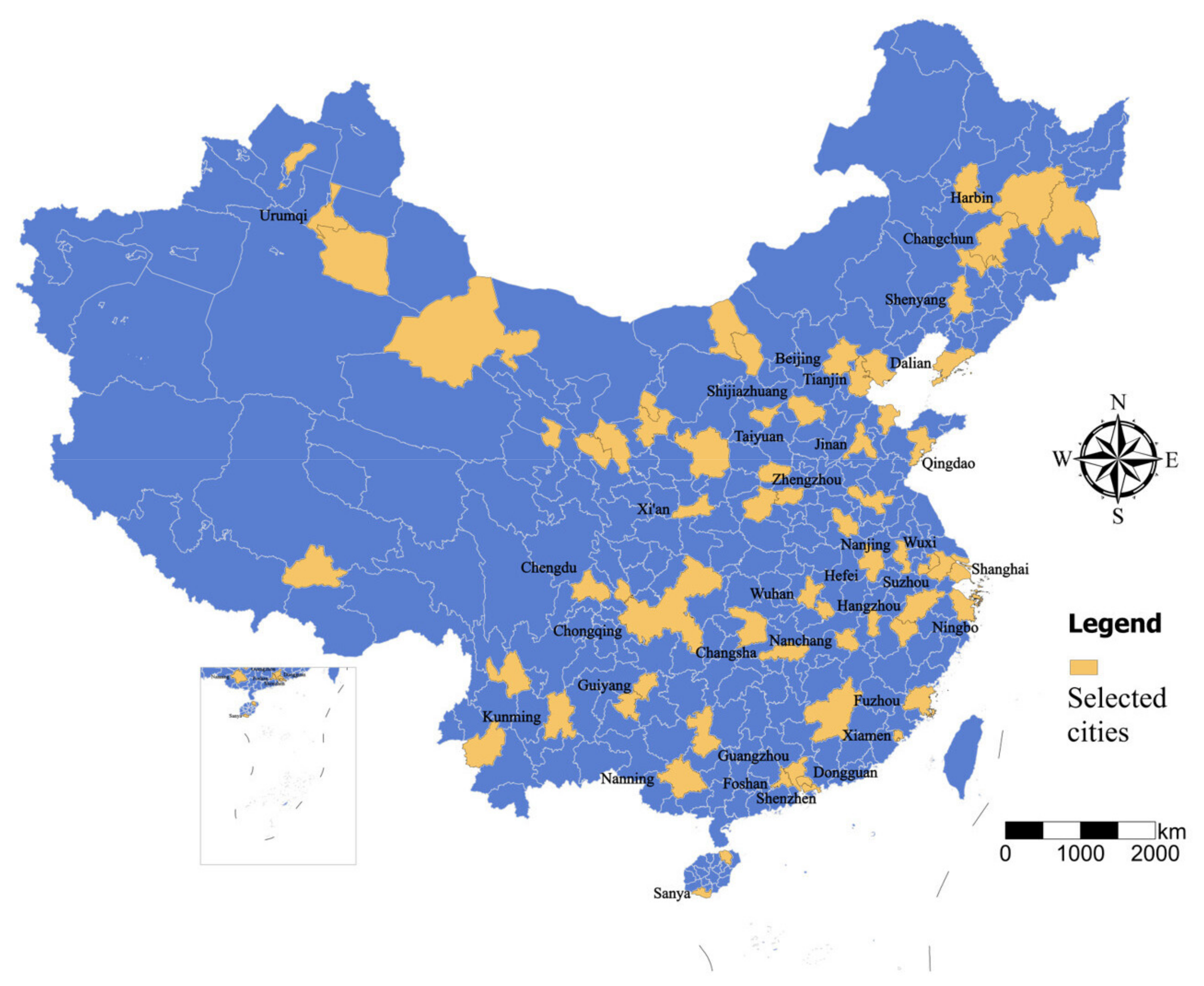

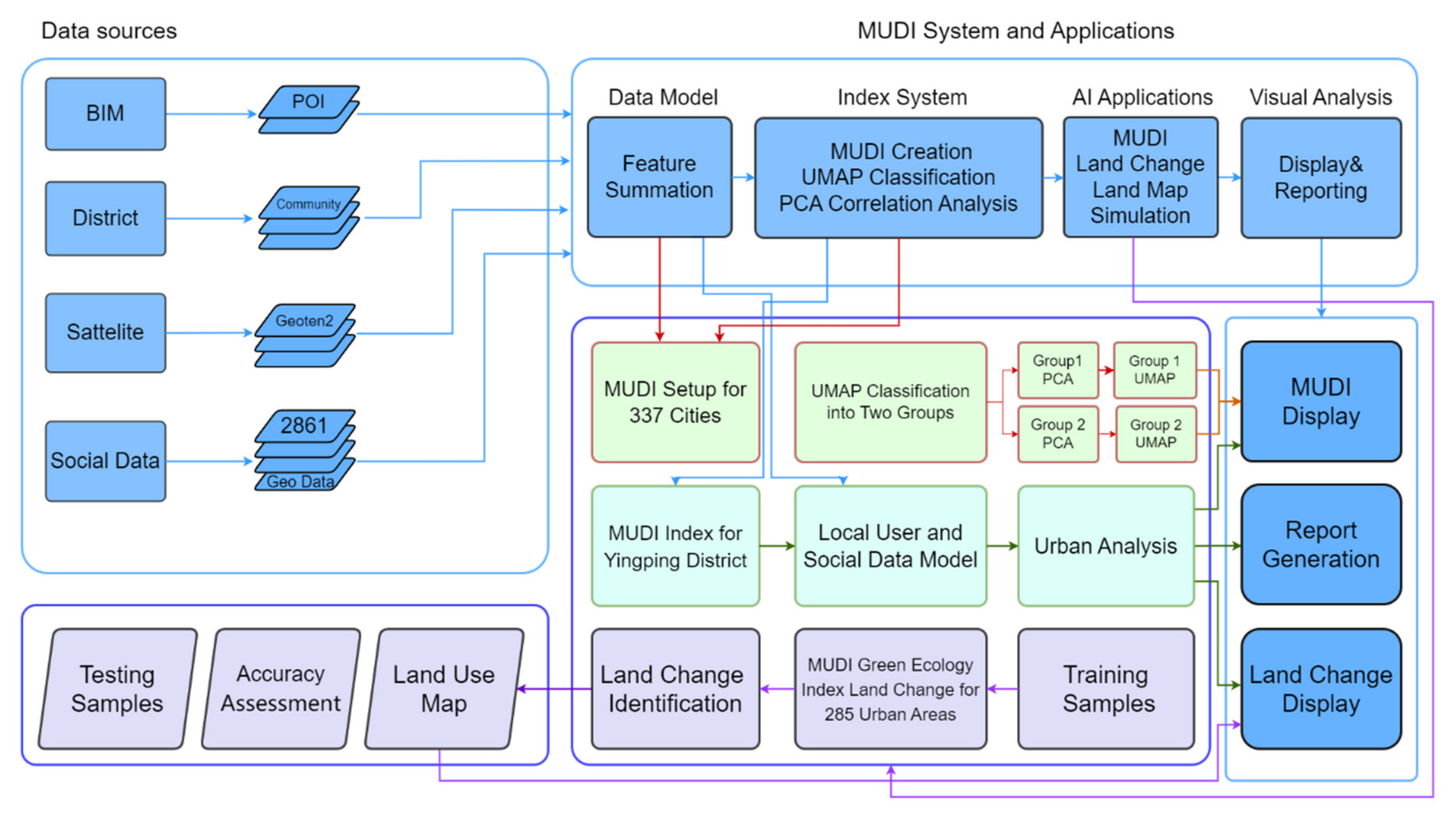
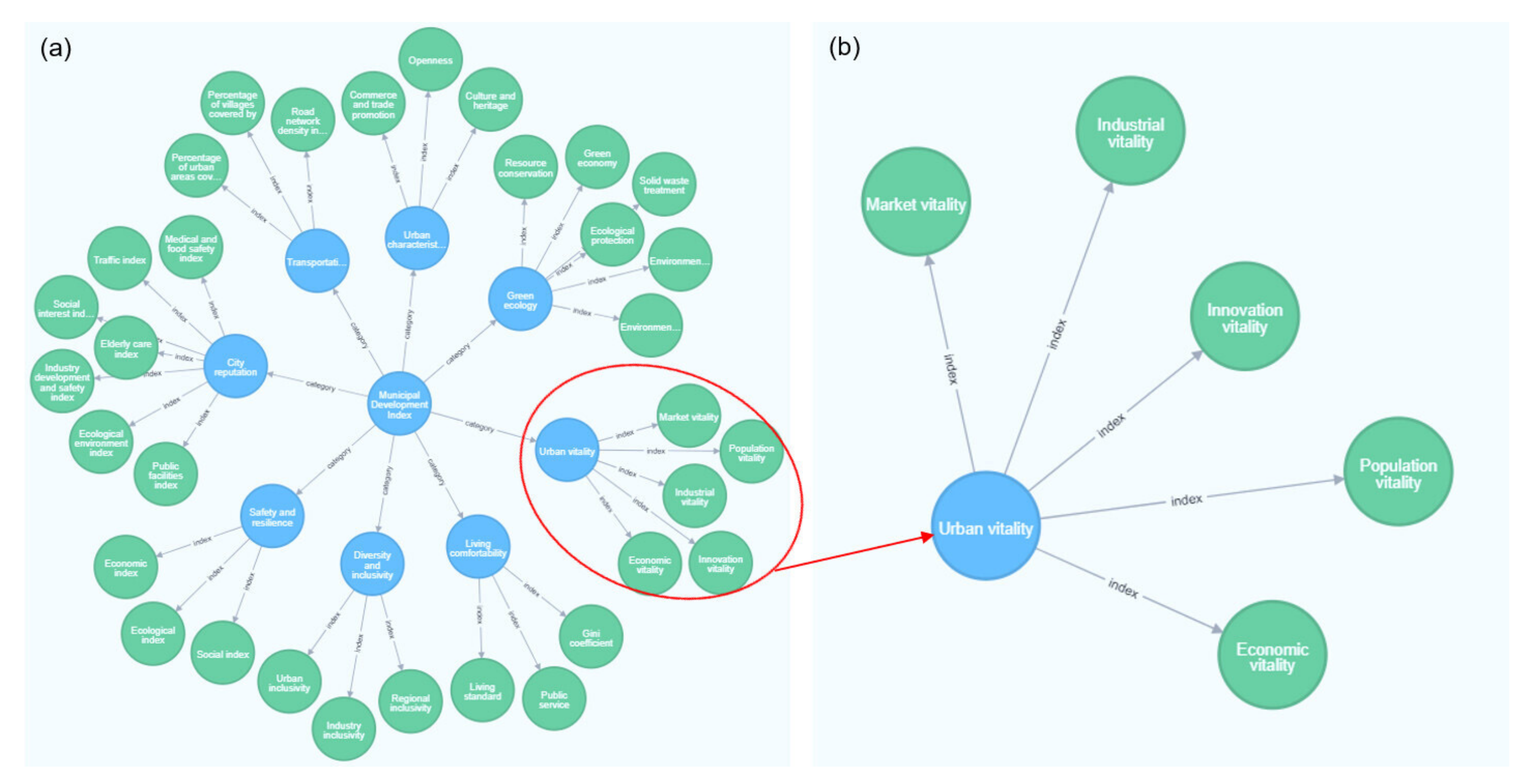
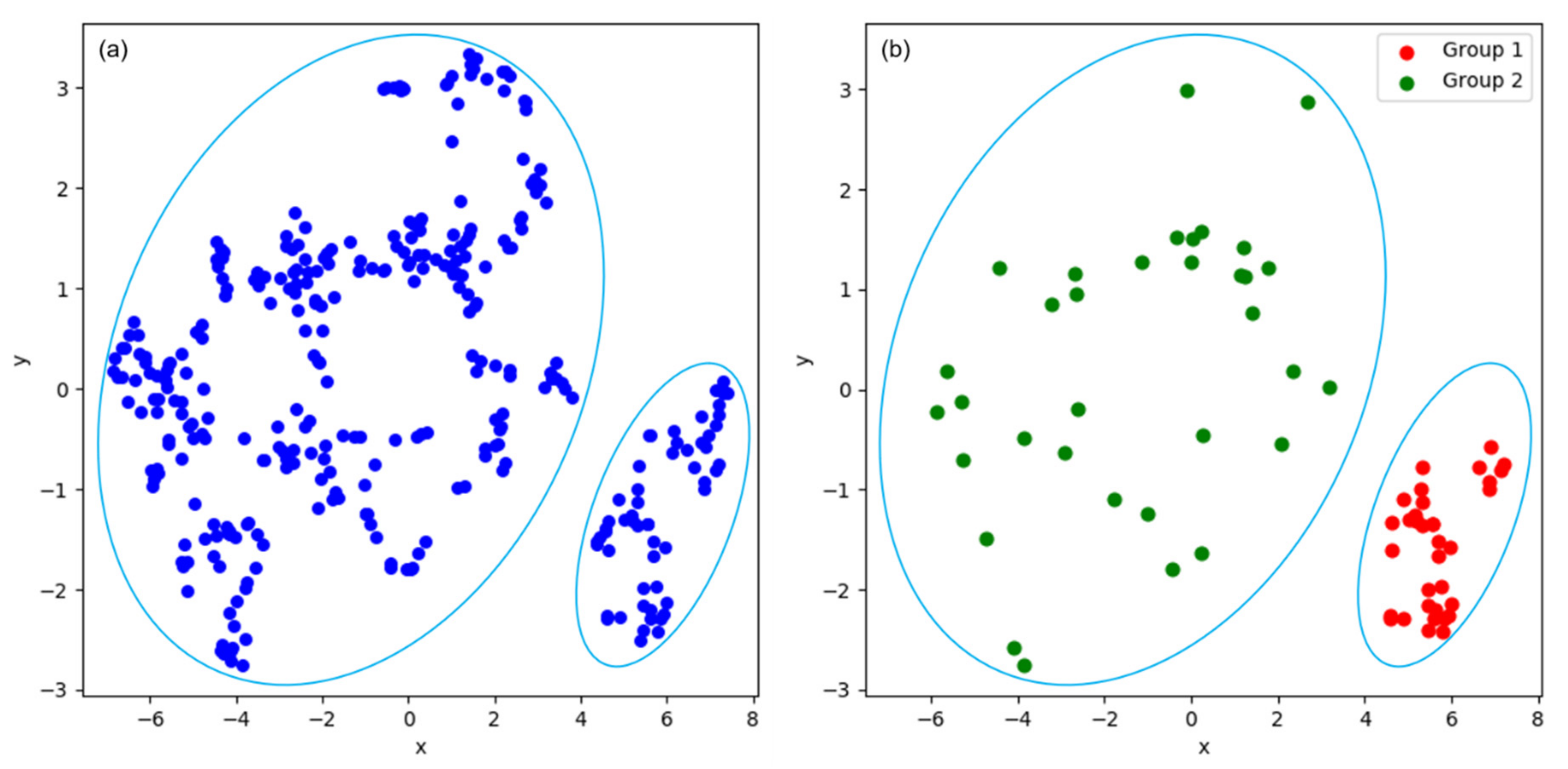

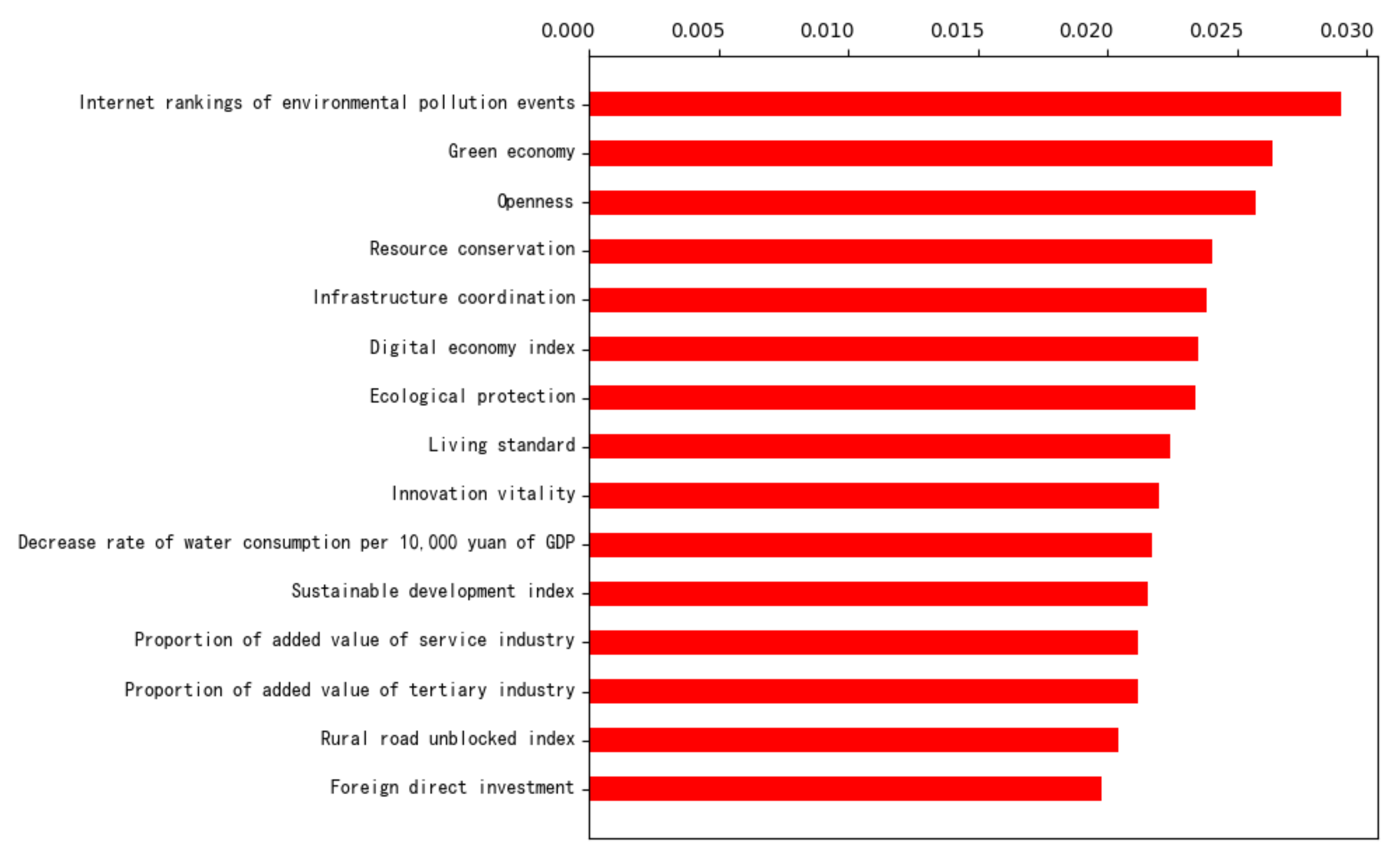

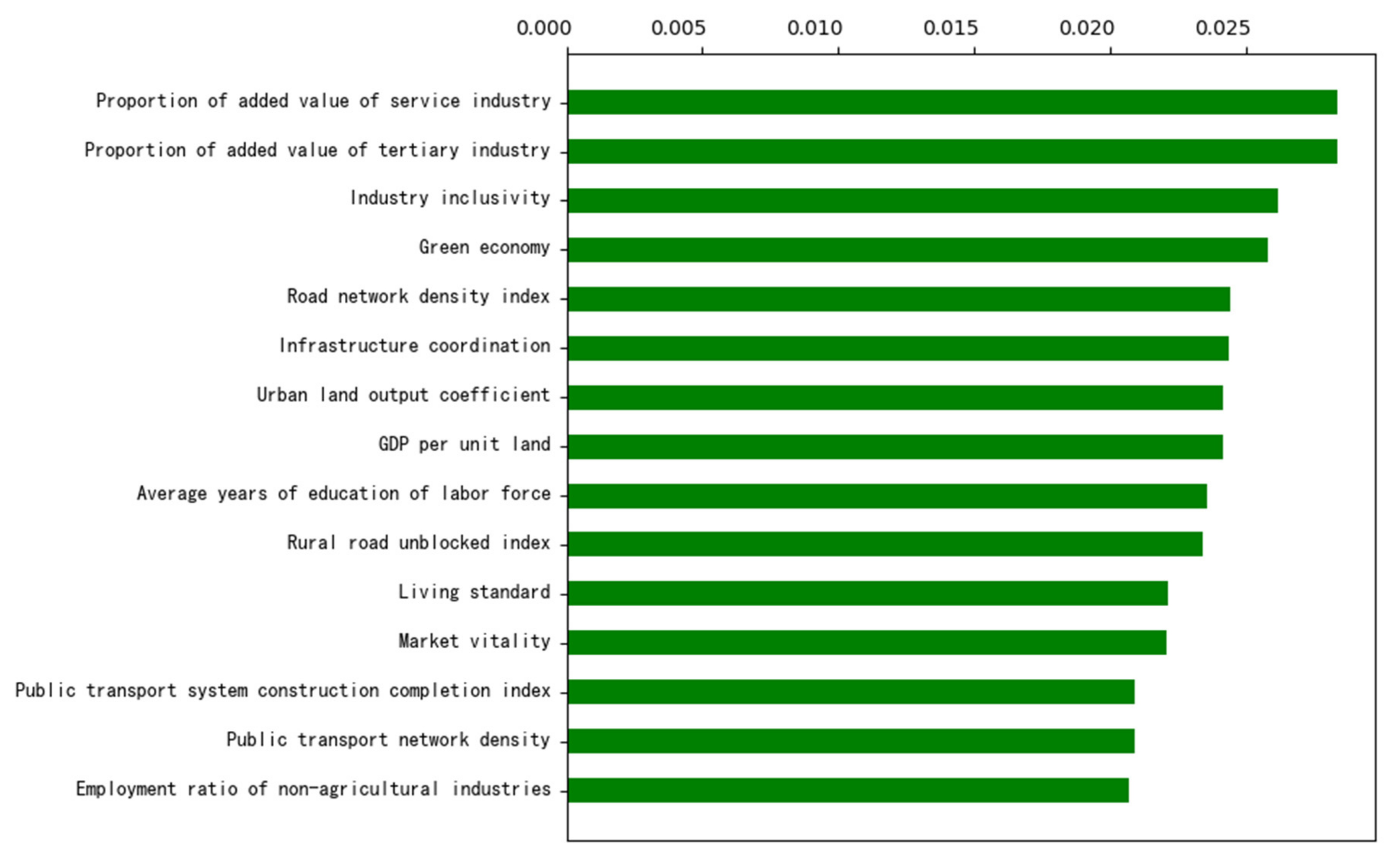
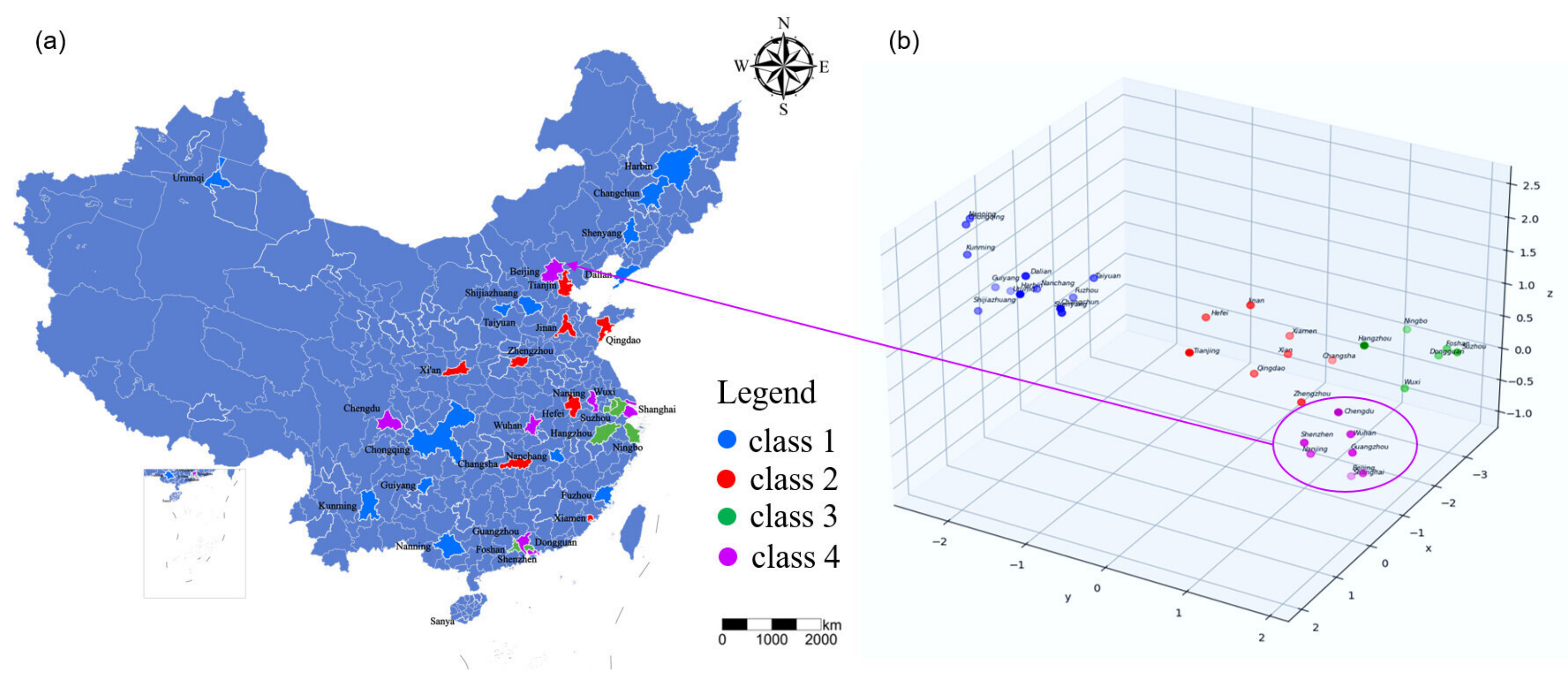
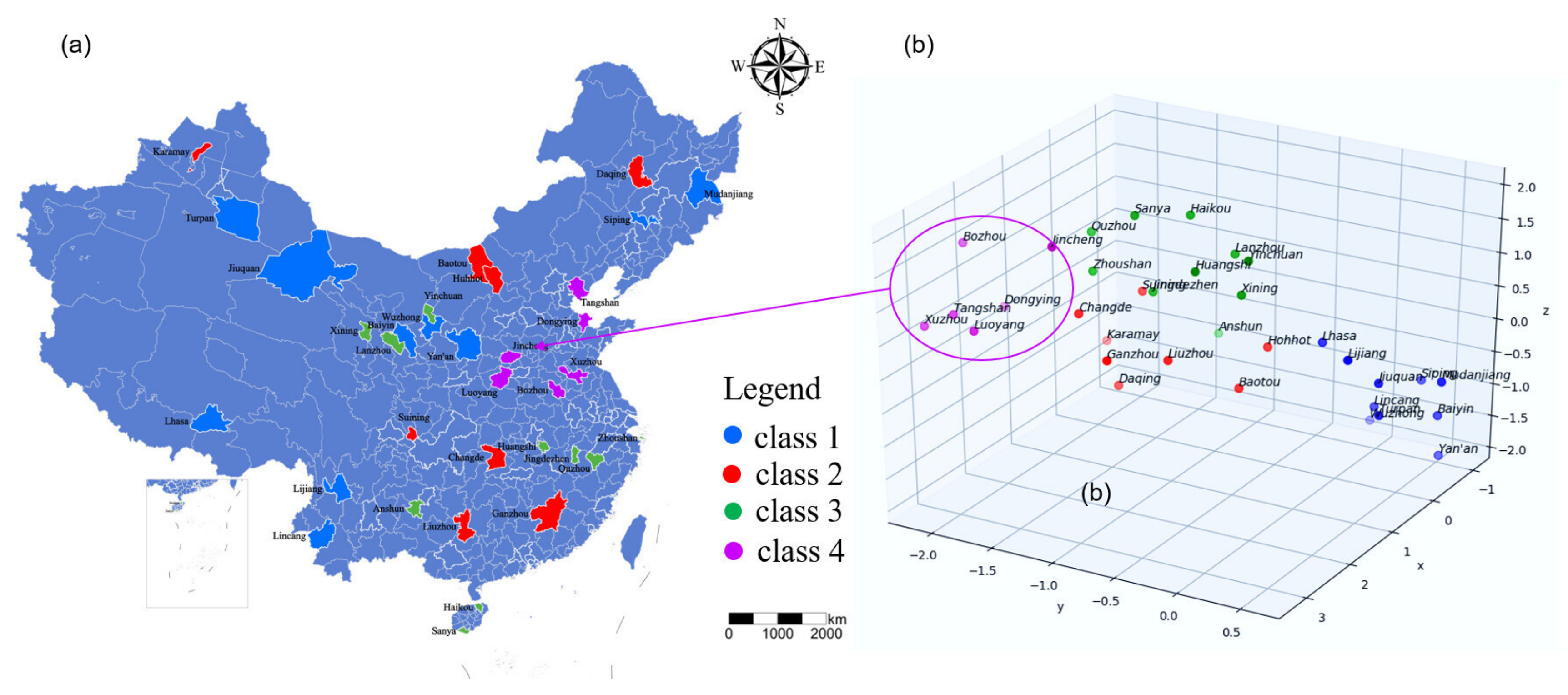
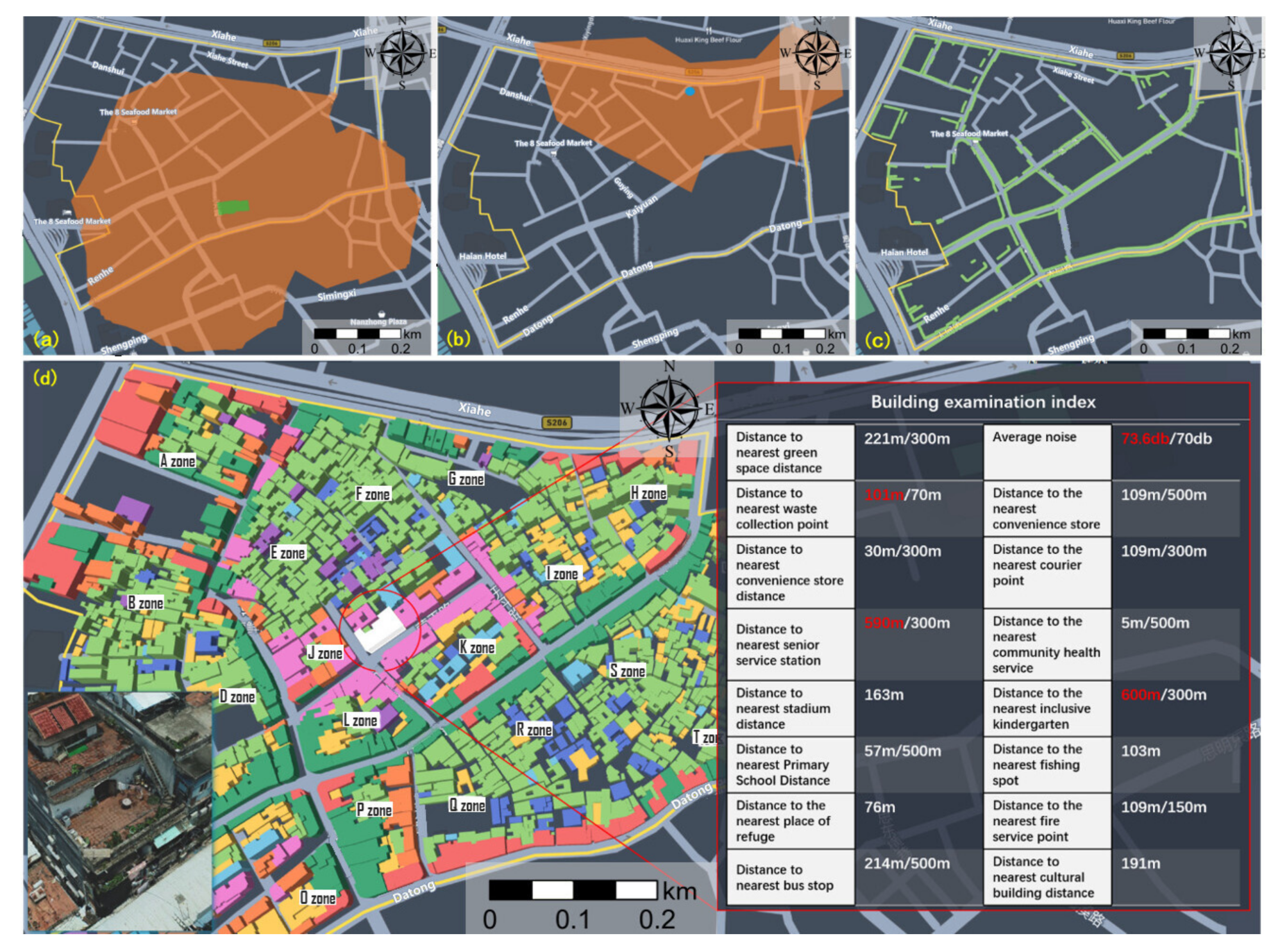
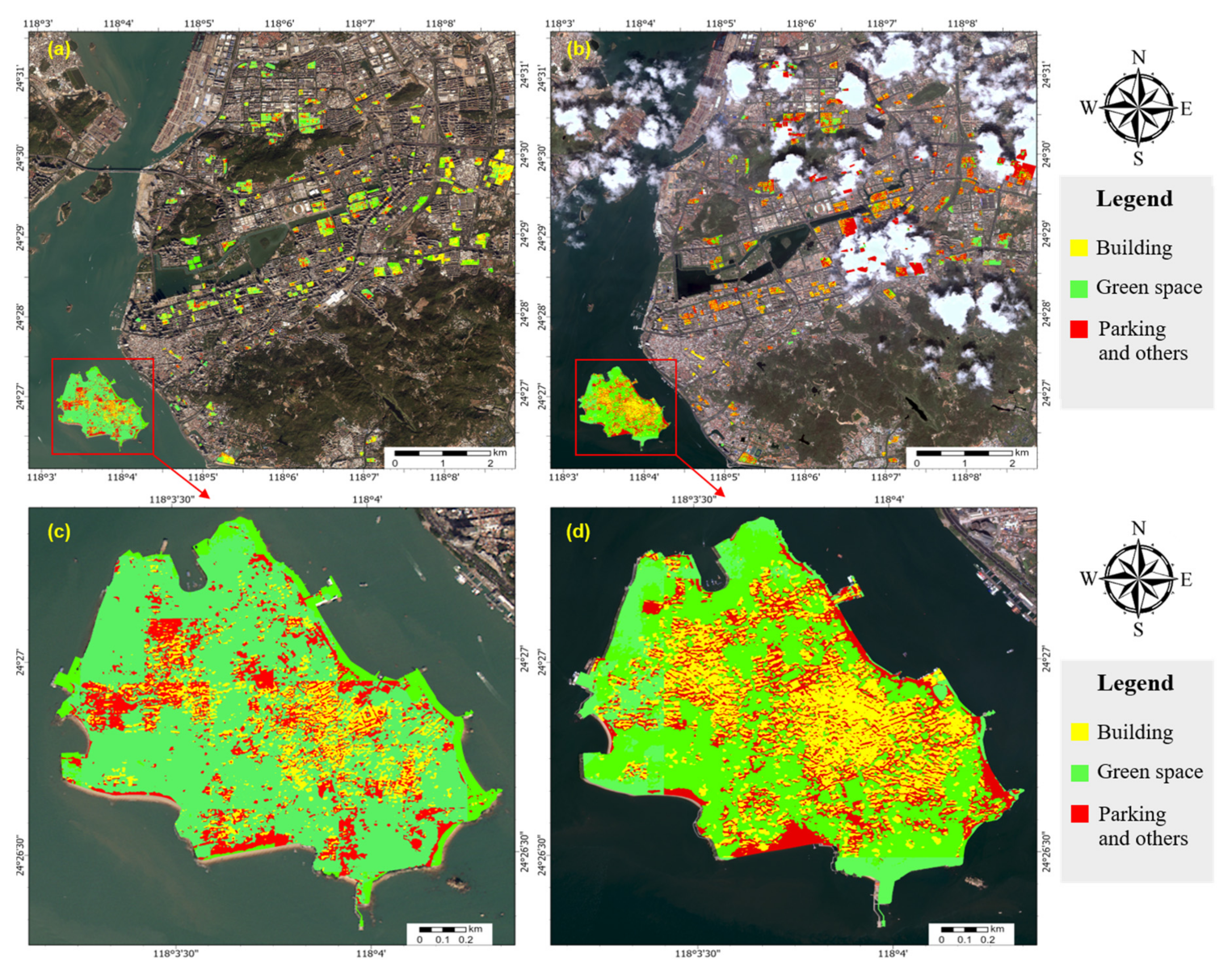
| Category | Level I Index | Level II Index |
|---|---|---|
| Urban Vitality | Economic vitality | Foreign direct investment |
| R&D expenditure ratio to GDP | ||
| Number of top 500 private-owned enterprises | ||
| Number of unicorn enterprises | ||
| Number of high-tech enterprises | ||
| Population vitality | Working age population ratio | |
| Working age average education level | ||
| Number of R&D personnel per 10,000 people | ||
| Full-time R&D equivalent of scientific researchers | ||
| Labor force demand ratio for higher education personnel | ||
| Innovation vitality | Patent applications | |
| PCT patent applications | ||
| Certified ICT patents | ||
| Contract amount of technology transactions | ||
| Urban land output coefficient | ||
| Fixed assets investment output for GDP | ||
| Industrial vitality | Value increase in high-tech industry | |
| Ration of value increase in high-tech industry | ||
| Exports ratio of high-tech product | ||
| Ratio of value increase in cultural and creative industries to GDP | ||
| Market vitality | Number of universities and research institutions | |
| Business environment index | ||
| Market economy index | ||
| Number of national free-trade zones | ||
| Number of market economy entities | ||
| Number of mobile phone users | ||
| Number of Internet users |
| Categories | Level I Index | Level II Index |
|---|---|---|
| Ecological and Living Environment | Ecological environment | Coverage rate of green space per neighborhood area |
| Coverage rate of building space per neighborhood area | ||
| Proportion of roads length with poor lighting | ||
| Proportion of roadway with wet ground | ||
| Proportion of roadways with environmental noise conforming to standard | ||
| Habitat sanitation | Number and coverage of garbage collection stations | |
| Number and coverage of sanitation facilities | ||
| Health and Comfort | Senior and elderly facilities | Number and coverage of convenient community commercial service facilities |
| Number and coverage of elderly community service stations | ||
| Proportion of the number of beds in elderly community service stations to the number of elderly people | ||
| Health care | Number and coverage of community medical service stations | |
| Number of beds in community medical service station | ||
| Per capita area of community sports venues | ||
| Education facilities | Coverage of inclusive kindergartens | |
| Number of kindergarten student permissions per thousand | ||
| Primary school coverage | ||
| Number of primary school student permissions per thousand | ||
| Safety and Resilience | Facility security | Intactness rate of important pipeline network |
| Density of waterlogging points in the neighborhood area | ||
| Area of emergency shelter per capita | ||
| Coverage of fire service stations | ||
| Annual number of safety accidents in the neighborhood | ||
| Residential safety | Number of dilapidated houses in the neighborhood | |
| Proportion of the area of dilapidated buildings to the total area of buildings | ||
| Transportation Convenience | Transportation convenient | Public transport station coverage |
| Proportion of continuous pedestrian road facilities to the total number of roads | ||
| Proportion of cut-off roads to total roads | ||
| Parking facilities | Parking area per capita | |
| Proportion of residential parking space to total number of households in the neighborhood | ||
| Proportion of commercial and public parking spaces | ||
| Cultural Characteristics | Cultural characteristics | Cultural presenting building area per 10,000 people |
| Historical buildings protection | Listing rate of historic buildings in the neighborhood | |
| Vacancy rate of historic buildings in the neighborhood | ||
| Protection and repair rate of historic buildings in the neighborhood | ||
| Street style | Proportion of streets with distinctive features in the neighborhood | |
| Distinctive cultural area that is in poor-quality conditions | ||
| Area with well-preserved historical features | ||
| The largest single area of the neighborhood with well-preserved historical features | ||
| Tidiness | Street tidiness | Street pole and skyline regularity |
| Tidiness ratio of buildings | ||
| Orderliness of street vehicle parking | ||
| Diversity and Inclusivity | Group inclusivity | Rate of barrier-free roads |
| Proportion of people living on subsistence allowances in the neighborhood | ||
| Proportion of migrant workers in the neighborhood | ||
| Elderly population ratio in the neighborhood | ||
| Proportion of the per capita housing area of public housing in the neighborhood is lower than the national standard | ||
| Housing guarantee | Proportion of guaranteed housing in the neighborhood | |
| Vitality and Innovation | Existing commercial and industrial status | Main store types in the neighborhood |
| Emerging commercial and industrial development | Proportion of special-characteristics shops in key commercial streets to total shops | |
| Proportion of creative and innovative shops in key streets | ||
| Proportion of mobile street stalls in the neighborhood | ||
| Store customer flow | ||
| High-quality brand ratio | ||
| Number of business types | ||
| Shopping environment evaluation |
| Beijing | Tianjin | Shanghai | Chongqing | Shijiazhuang | Taiyuan | Harbin |
| Changchun | Shenyang | Dalian | Jinan | Qingdao | Nanjing | Hefei |
| Hangzhou | Ningbo | Fuzhou | Xiamen | Zhengzhou | Wuhan | Changsha |
| Guangzhou | Shenzhen | Nanning | Kunming | Chengdu | Xi’an | Urumqi |
| Nanchang | Guiyang | Wuxi | Suzhou | Foshan | Dongguan |
| Tangshan | Jincheng | Hohhot | Baotou | Daqing | Siping | Dongying |
| Xuzhou | Bozhou | Quzhou | Jingdezhen | Ganzhou | Luoyang | Huangshi |
| Changde | Haikou | Sanya | Liuzhou | Lincang | Anshun | Suining |
| Yan’an | Lanzhou | Baiyin | Yinchuan | Wuzhong | Karamay | Xining |
| Lhasa | Mudanjiang | Zhoushan | Lijiang | Jiuquan | Turpan |
| Building | Green Space | Parking and Others | OA | Kappa |
|---|---|---|---|---|
| 72.75% | 78.30% | 68.50% | 72.79% | 0.5839 |
Disclaimer/Publisher’s Note: The statements, opinions and data contained in all publications are solely those of the individual author(s) and contributor(s) and not of MDPI and/or the editor(s). MDPI and/or the editor(s) disclaim responsibility for any injury to people or property resulting from any ideas, methods, instructions or products referred to in the content. |
© 2024 by the authors. Licensee MDPI, Basel, Switzerland. This article is an open access article distributed under the terms and conditions of the Creative Commons Attribution (CC BY) license (https://creativecommons.org/licenses/by/4.0/).
Share and Cite
Wang, X.; Li, X.; Wu, T.; He, S.; Zhang, Y.; Ling, X.; Chen, B.; Bian, L.; Shi, X.; Zhang, R.; et al. Municipal and Urban Renewal Development Index System: A Data-Driven Digital Analysis Framework. Remote Sens. 2024, 16, 456. https://doi.org/10.3390/rs16030456
Wang X, Li X, Wu T, He S, Zhang Y, Ling X, Chen B, Bian L, Shi X, Zhang R, et al. Municipal and Urban Renewal Development Index System: A Data-Driven Digital Analysis Framework. Remote Sensing. 2024; 16(3):456. https://doi.org/10.3390/rs16030456
Chicago/Turabian StyleWang, Xi, Xuecao Li, Tinghai Wu, Shenjing He, Yuxin Zhang, Xianyao Ling, Bin Chen, Lanchun Bian, Xiaodong Shi, Ruoxi Zhang, and et al. 2024. "Municipal and Urban Renewal Development Index System: A Data-Driven Digital Analysis Framework" Remote Sensing 16, no. 3: 456. https://doi.org/10.3390/rs16030456
APA StyleWang, X., Li, X., Wu, T., He, S., Zhang, Y., Ling, X., Chen, B., Bian, L., Shi, X., Zhang, R., Wang, J., Zheng, L., Li, J., & Gong, P. (2024). Municipal and Urban Renewal Development Index System: A Data-Driven Digital Analysis Framework. Remote Sensing, 16(3), 456. https://doi.org/10.3390/rs16030456










